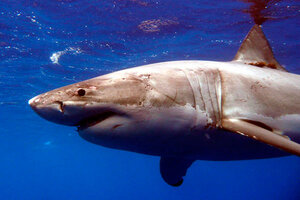Manhattan Beach great white attack: Was the shark provoked?
The great white shark attack in Manhattan Beach, Calif., Saturday happened when a swimmer accidentally swam toward a shark that had been hooked by a fisherman 45 minutes before and was struggling to get free.

An adult great white shark prowls the waters of the eastern north Pacific. A seven-foot juvenile attacked a swimmer in Manhattan Beach, Calif., Saturday after being hooked by a fisherman.
Kevin Weng/University of Hawaii/Reuters/File
Shark attacks are so rare that each incident is, by its very nature, unusual. But the attack by a great white shark near the Manhattan Beach Pier in southern California Saturday appeared to be the result of a particularly unusual circumstance.
Officials at the beach said the shark had been hooked by a fisherman on the pier and had been trying to free itself for about 45 minutes before a long-distance swimmer unknowingly swam into its path.
The shark "was trying to get off the line," Capt. Tracy Lizotte, a Los Angeles County lifeguard at the beach, told the Los Angeles Times. "He was agitated and was probably biting everything in his way, and then the swimmer swam right into the shark's line."
Eyewitness Eric Martin told KABC-TV that the shark didn't appear to intend to bite the swimmer but was trying to shake free of the line. "We think the swimmer just happened to be at the wrong place at the wrong time," he said.
The swimmer, Steve Robles of the Southern California Aquatics Team, is in stable condition. The fisherman cut his line after Mr. Robles was injured.
The Florida Natural History Museum, which keeps a record of unprovoked shark attacks, says "unprovoked attacks happen when sharks make the first contact." Provoked attacks come from humans touching sharks. The ReefQuest Centre for Shark Research adds: "A provoked shark attack may be defined as any physical contact with a human by a shark that was apparently precipitated by the former cornering, pursuing, striking, grabbing, spearing, hooking, shooting, or otherwise molesting the latter."
The incident highlights the growing interface between humans and white sharks. Last month, two scientific surveys found that white shark populations were growing off both coasts as conservation efforts improve. At the same time, more people are using coastal waters not just for bathing, surfing, and – in this case, long-distance swimming – but also for kayaking and other activities.
A reader for the Manhattan Beach Patch commented that the fisherman who was attempting to catch the white shark Saturday frequently fishes for sharks. Local officials have noted an increase in the number of juvenile white sharks in the area.
The result of these trends is more encounters on both coasts. George Burgess, director of the Florida Program for Shark Research, has forecast more shark attacks in the US this summer.
"Each year, more people are going into the water," he told Discovery News. "We're also seeing a rise in numbers of sharks on both coasts."
There were 47 unprovoked shark attacks in US waters in 2013, two of which were fatal. Those numbers are within the normal range seen since 2000. Shark attacks rose steadily from the late 1980s to 2000, according to a chart by the Florida Museum of Natural History.
Increasingly, with the proliferation of smartphones, encounters with white sharks have also been through viral videos on social media. Videos in recent years have shown white sharks circling fishing boats, biting fishing boats, and checking out sea kayaks. Last month, fishermen shared a video of themselves catching a small white shark a mile from a popular New York beach.
To avoid potential shark attacks, swimmers should avoid the ocean at dawn and dusk, when sharks are most active, and should not wear shiny jewelry, which can look like the glint of fish underwater, experts say.
The city of Manhattan Beach has halted all fishing off its pier until Tuesday.

